First rainbow of 2022. Even fainter than last year’s. I hope that’s not an omen.

–Simon

Because the thought occurred now and it might be gone tomorrow
Last year I mentioned the need for a root cellar.
This was predicated upon the expectation of a large potato crop–the results of my hand made potato box.
The final yield was, however, lackluster, and my other root crops, onions and garlic, don’t require root cellar conditions.
But the carrots did exceptionally well, and storing them in a combination of the crisper drawer in the fridge and the garage, well, was annoying. So I revisited my plans to convert the crawlspace.
All I intended was to add some shelving, but I never got around to it, and my earlier attempts at using it for storing radishes resulted in a box of moldy radishes. I abandoned the plan.
Then our chest freezer died. Its thermostat had always been finicky, refusing to settle anywhere between 0 and -30. And when the power went out, the compressor never clicked back on again.
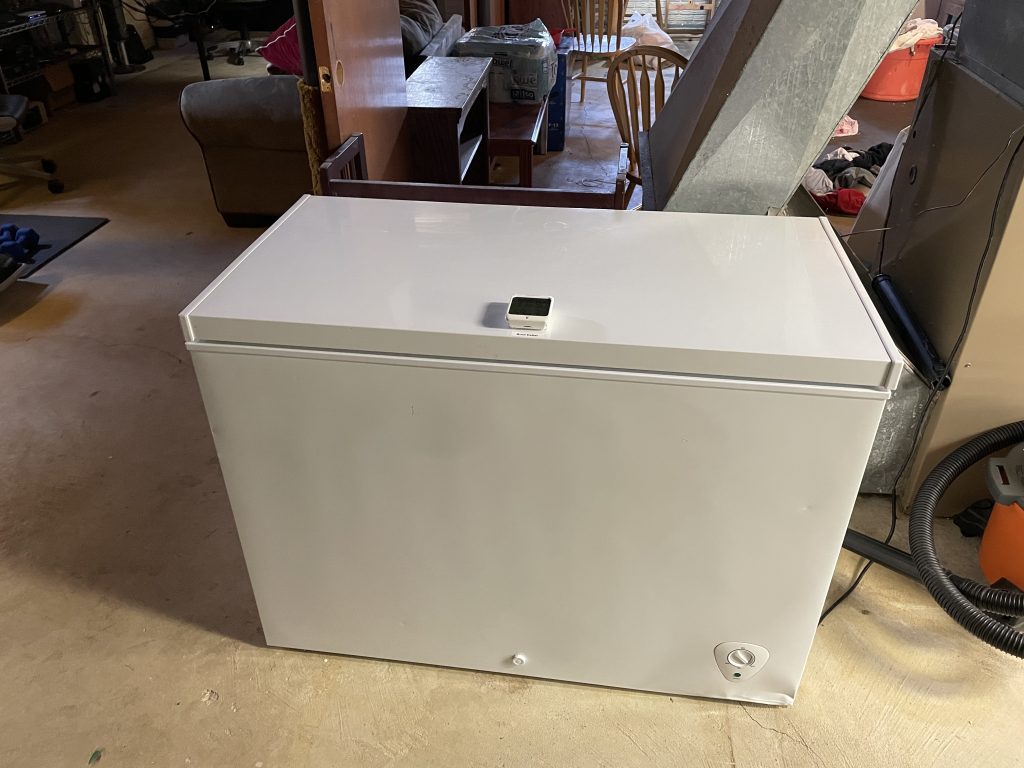
Everyone surely remembers the great toilet paper shortage of COVID. Faced with a temporary yet inconvenient possibility of having to wait a few days to buy what we wanted immediately, people began stockpiling items they were most afraid of going a day without: food, sanitary products…ammunition…?
You never know when you might need to shoot your neighbor because they bought all the toilet paper. And apparently that’s going to require a thousand rounds.
Anyway, on this list was deep freezers, to store all this frozen food that you might have to go a day without. And now, almost a year after the quarantines, they’re apparently still hard to find. But find one we did, at a former Sear’s warehouse, for too much money. But it was either that or lose all the steak, and I’ll be damned if I have to go a day without steak. So we bought it and lugged it home and hooked it up and…at that point I noticed the old freezer had finally clicked back on.
God dammit.
But then I got an idea. We could take it back, or I could convert the old glitchy one into a root cellar! Which is essentially just a giant refrigerator. It’s impossible to keep a dirt cellar 33-40 degrees with 98% humidity anyway. So while this approach might not be more efficient, it was certainly more effective.
But one problem remained: freezers aren’t refrigerators and aren’t designed to act as such. Fortunately, that problem had already been addressed. The market is flooded with thermostatic controller overrides, which turn the power on and off to the external cord independently of the freezer’s wonky and cheap internal thermostat.
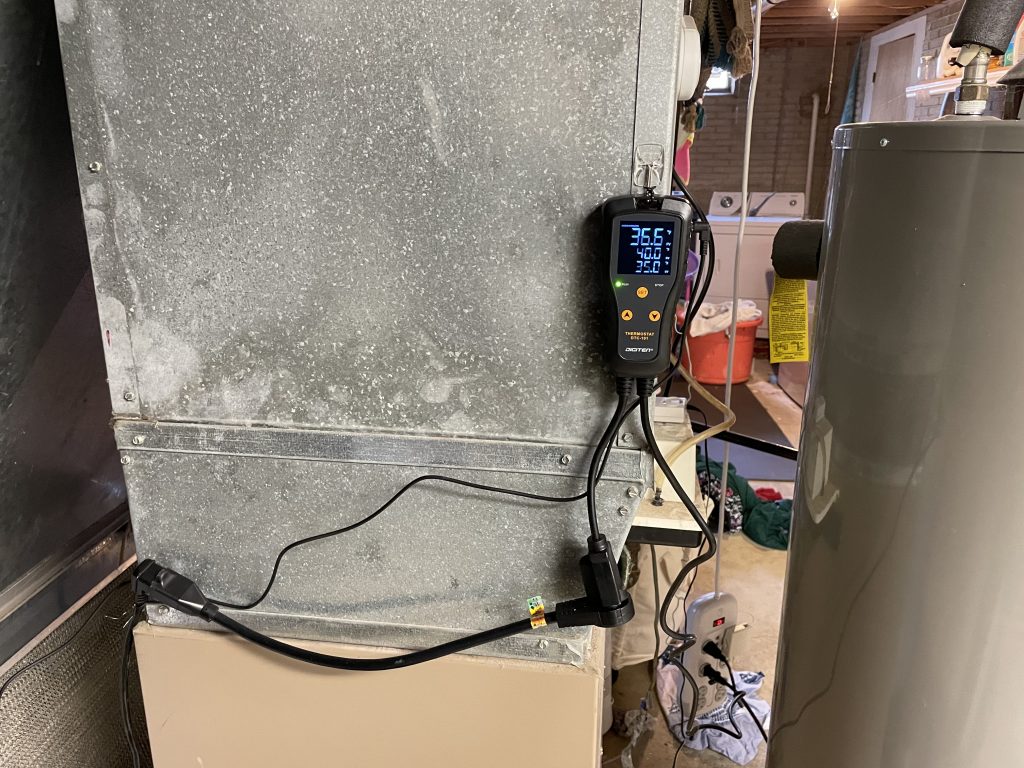
So far it’s working pretty well, though I might add some water jugs in there to help regulate. It tends to turn on and off more frequently than I’d like. I know compressors don’t like that.
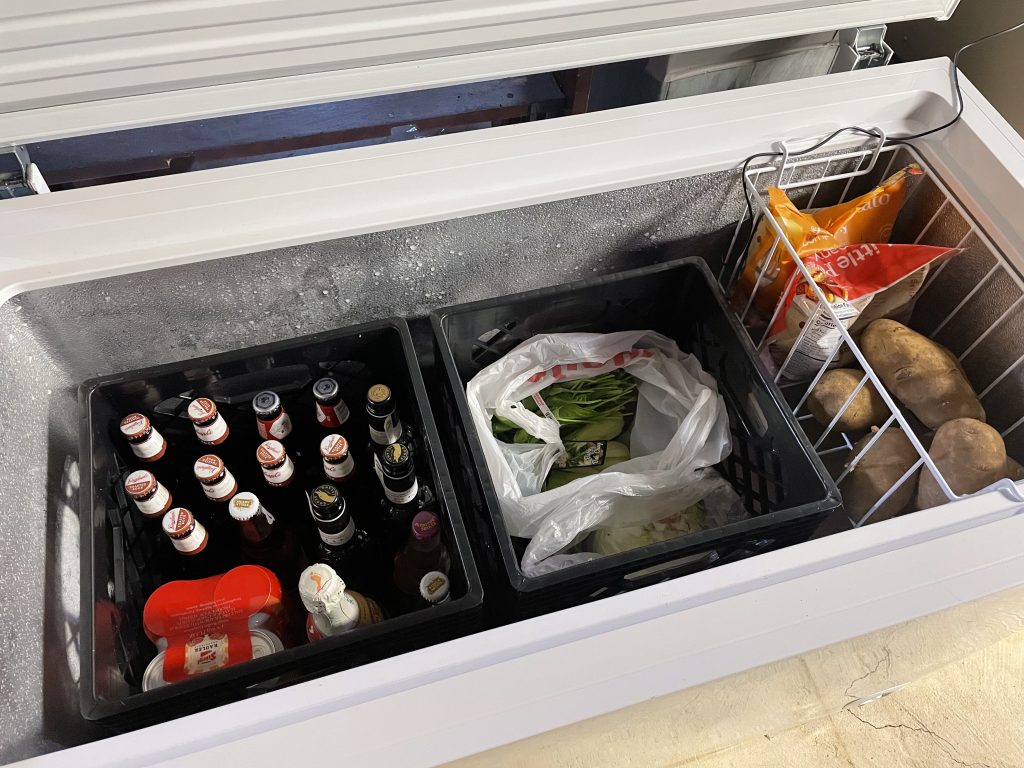
And with one last addition, milk crates, I have stackable storage in there too, which keeps things off the metal liner (hopefully this will also prevent frostbite). And even though these reduce the usable space, it’s still a ton of storage. I even thawed a turkey in there last week, so there’s certainly uses beyond just vegetables.
I won’t have to occupy an entire fridge door for a week brining pork belly for bacon, either. And that’s something I’m unwilling to go a day without!
–Simon
I had a post going, but it was another Baby Boomer one, and hating on the Boomers gets old even for me. So I’ll push down that hate for a bit longer and puke up a different kind: idiot homeowners.
I should turn these events into a series, really, because every time I begin a home repair or improvement, I find evidence of unsafe and shoddy previous home repairs/improvements. The gem today being the master bathroom fan, which never vented properly, resulting in a constant war on mold. And with the air in this region already terrible, I’m certain it was doing nothing good to my respiratory ailments.
Something had to be done.
I had previously made an attempt to fix the ventilation, going so far as to stretch ductwork up through the attic to the roof vent, so it was surprising that it still wasn’t doing the job. Obviously I needed to replace the fan with a more powerful model. So after some examination of the space and mounting required from the attic side, I procured a super suckerpator 3000. Or something like that. Samsung, I think. 120cfm/min. Awww yeah!
After some infuriating screw removal with constantly failing drill batteries, I pulled the fan from its mount. The cover, which obviously should have been removed prior, dislodged and crashed to the bathroom floor. I peered through the opening, and encountered a different arrangement of shapes and colors than I was expecting. It was the wrong bathroom.
I expressed my anger with the appropriate words which, accompanied by the sound of the fan cover a moment prior, summoned an inquisitive wife. But, as the bathroom in question was already being dismantled for a remodel, it was a minor setback. I’ll just have to replace that fan later.
But, where in the hell was the other fan? No evidence of its existence was apparent from the attic. Exploratory house surgery was needed.
So I removed the fan cover in the proper bathroom, pushed a wire up the side of the fan, and employed some assistance to wiggle the wire while I looked for movement back up in the attic. Eventually, after peering about the far corners of hell, there it was: on the very edge of the attic where the roof met the eves. Translation: it was not attic-accessible. The new fan I bought required that. I had to get a different model.
Okay, that’s fine. There’s plenty of that variety on the market, obviously for scenarios where people are unable or unwilling to access the place from above. I picked out a new fan, albeit not as powerful (the super strong ones require brackets that mount into multiple joists).
No-attic access fans are mounted on just one side. Two metal flanges with holes are attached to a single rafter. The new fan was designed this way, as was the old fan. But the old fan was attached with 12 gauge fencing staples, which meant I had to reach up past the drywall with pliers and gradually wrench and twist the dam things out. And the drywall, having been subjected to decades of mold and moisture, was none too resilient. It crumbled away in the process, much of it hitting me in the face, until eventually the staples were removed and I could pull the old fan out.
And there the problem was revealed.
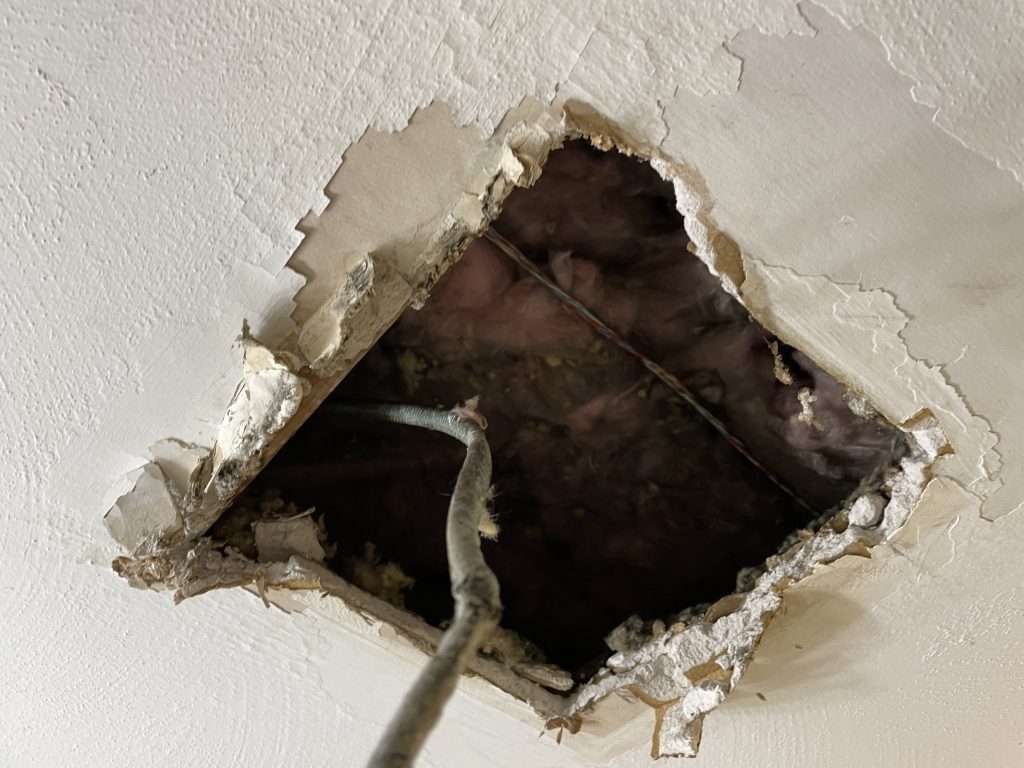
A casual observer might notice that the insulation was rolled out on top of the fan. And no, no provision for the vent was made. All this time, the bathroom was venting into this tiny space, causing water damage.
Well, at least I know now. No sense getting angry.
HAHAHA, NO I LIED! CURSE YOU, YOU STUPID PRIOR HOMEOWNER WHO DID THIS! I HOPE YOUR DEATH IS PAINFUL AND LONELY!
…
Okay, back to the story.
The new fan installed with minor problems, but now that the drywall had disintegrated, I was left with yet another problem.
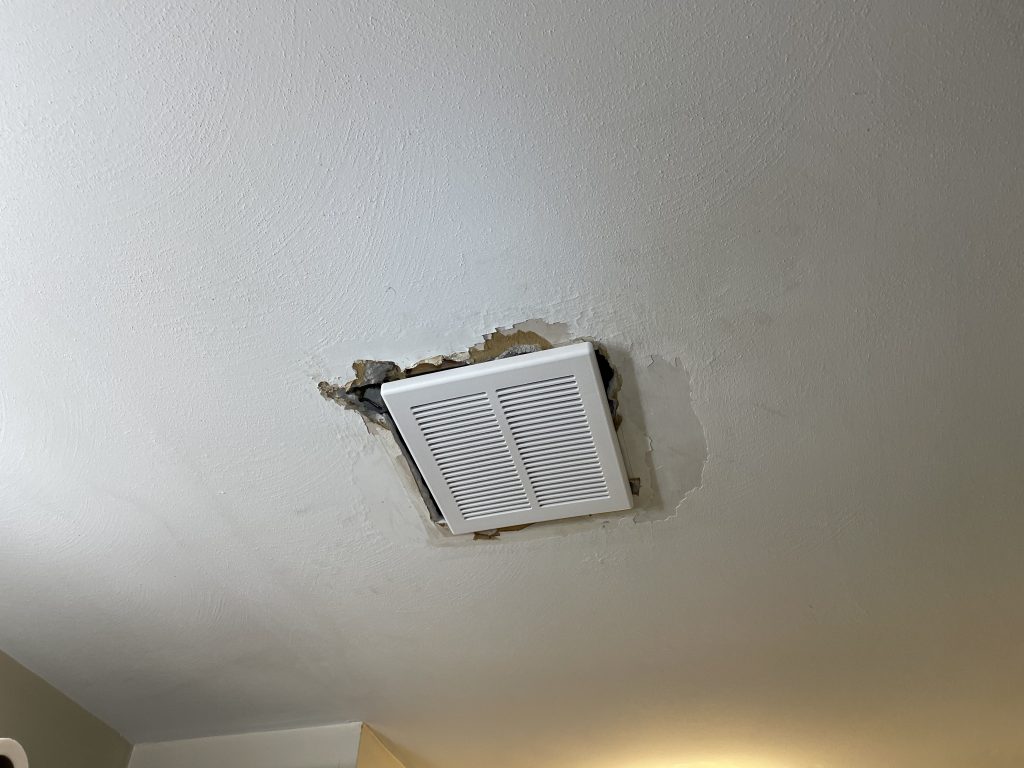
Okay, yeah that’s not going to work.
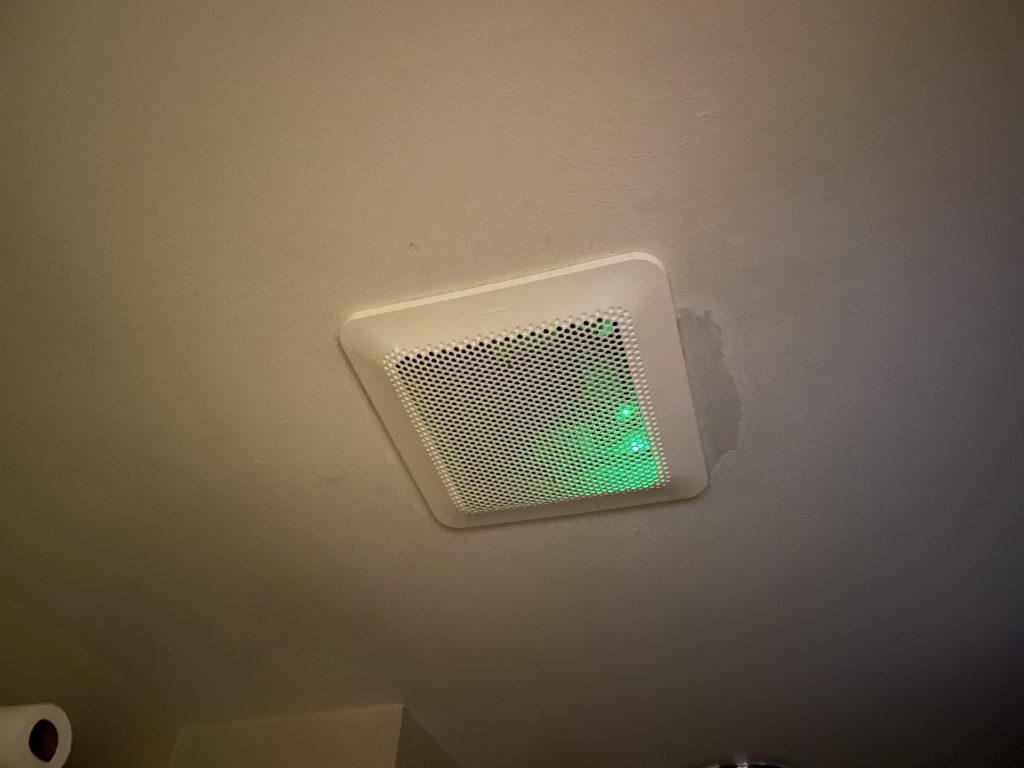
That’s better.
I used the cover from the other fan. I’ll patch things up later, and of course I’ll need to procure another cover, but for now I at least have some proper ventilation. Finally.
Idiot homeowners.
–Simon
There’s a story I like to share, because it’s a fantastic example of an old couple argument. It went something like this:
Once upon a time, LED lightbulbs weren’t a major player yet, and it was in that brief period where the world was adjusting to CFLs, and old conspiracy theorists everywhere were collapsing from ruptured aneurysms after the government started mandating energy consumption limits on illumination. Of all the things to worry over, and it took an NSA defector to get the general public to even acknowledge the government’s wholesale data mining of citizens’ digital lives–which, I might add, ended with the general public retaining their complete indifference. But those lightbulbs! The government’s up to something and we should be angry!

A more rational complaint with early CFLs was their color spectrum. Bright white lighting is but one source of the eternal migraine hell office workers must endure (a close second to bad bosses), and people were understandably reluctant to replicate those conditions at home. And so began the lightbulb stockpiling (and, you know, because of whatever the government was up to).
Now, as an aquarium keeper, I wondered why no one would make a more yellowish bulb, for the variety of different colored fluorescent T8s I’d kept in my tanks over the years had clearly demonstrated that the problem was already figured out.
I didn’t have to wait long. Manufacturers started making CFLs in more pleasant shades, and even printed the Kelvin rating. But the damage was done. It seemed no one trusted them, nefarious government plans notwithstanding.
Liz was one such slow adopter–not that she ever suspected crazy government plans. Rational suspicion of plausible evil government plans, sure, like what most normal people have. Nay, it came down to bad experiences with the early bulbs and the fact that the choice to use incandescents still existed, so why change? The only reason I cared myself was because the old bulbs burnt out so damn quick and were expensive to replace. There was a lightbulb cartel you know, which mandated an artificial lifespan of a maximum of 1000 hours. Not a government conspiracy maybe, but certainly mafia-corporate shenanigans.

To further place me into illumination cost woes, apartment wiring was generally limited to one switch-enabled outlet for a living room. One lamp on one switch. Turning the home from perpetual twilight into something by which one could actually read required a 250 watt bulb. These bulbs were not cheap, and as mentioned before, burnt out quickly. So I explored those new-fangled CFLs–a higher upfront cost, but a much longer operational life.
Being sure to buy a low-K bulb, I installed a CFL of the same lumen rating the next time the incandescent burnt out. Liz complained–when I suggested a CFL, when I was buying the CFL, and after I had installed the CFL. I couldn’t tell if the difference was significant or there was bias. So I hatched a plan: use the complainer as a test subject in a very brief blind study.
I ran back to the store and bought another incandescent, and swapped it when Liz wasn’t looking. I then waited, and when she again complained about the bulb I triumphantly removed the lamp shade to reveal the same type of incandescent which had been installed previously! Huzzah! Turns out no one could tell the difference. And all it took was a little bit of reverse-gaslighting my most trusted loved one. A small price for the sake of finances. She’d forgive me eventually.
In the meantime, I was cleared to finally start buying CFLs as old bulbs died. And when CFLs lost their popularity to LEDs (which applied the CFL spectrum lesson immediately), there was no argument.
But…LEDs didn’t take this lesson to heart in all products. Christmas lights were not given such discerning treatment. And while I argued for their merits, such as longevity and more robust construction (they didn’t burn out or fail catastrophically after being put up…usually), I had to concede that they just didn’t look as good as classic incandescents.
But then Liz found a style of LEDs that resembled them. So we switched over. But every year she fears a return to the olden days, and buys more of that type, on the chance that the manufacturer will discontinue them. And with more lights on hand, I put them up. And the following year she buys more. And I put those up too.
My point? Well, I just find it an amusing story in marital disagreements regarding changing illumination technologies. But she got her revenge. Each year I spend more time crawling around on the cold roof.
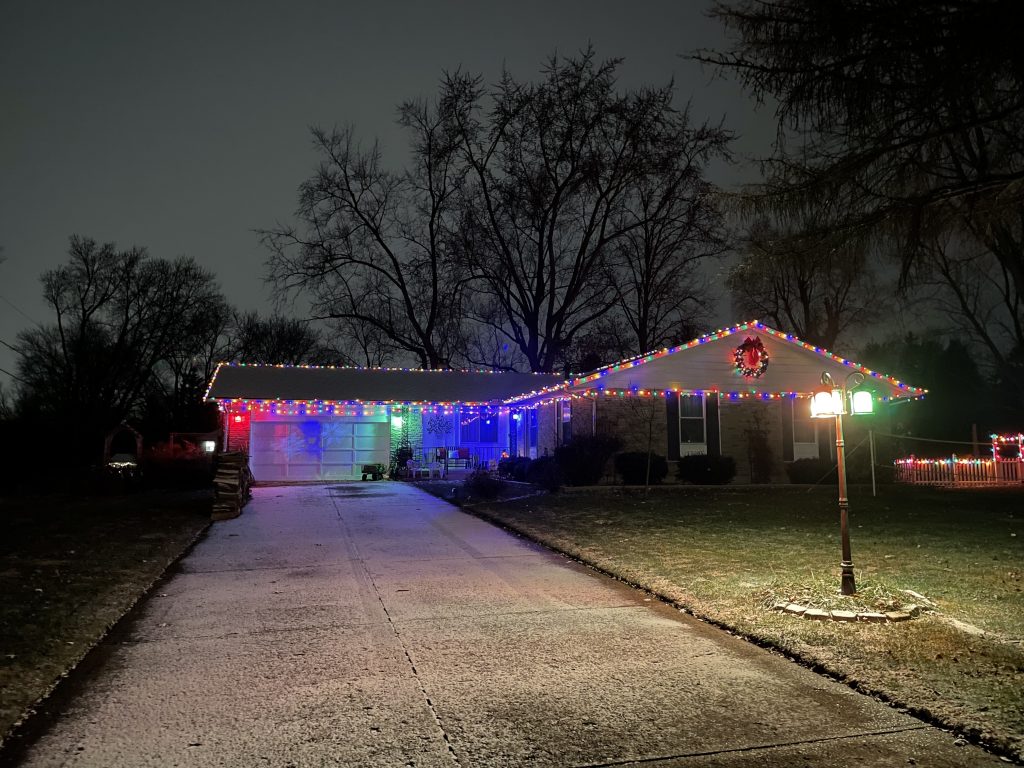
May your days be merry and bright–with 2700K spectrum LEDs.
–Simon
Appliances are the servants of the masses.
How badly can that Marx quote be parodied?
Still, it’s a relevant modern take. Appliances, created to save labor, instead become the baseline expectation. And while they may start as a luxury for the elite, they’re soon reduced in cost and made accessible to all. They may save labor, but do they really save us any time? Once everyone has them, they’re no longer life hacks. Appliances don’t give us leisure, they just provide more time with which we’re expected to do more productive tasks. And spend more money on the appliances’ maintenance.
But for that brief period of novelty, they’re great.
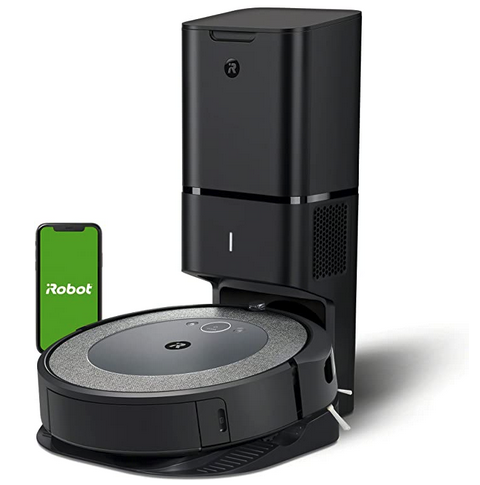
I had long considered robovacs to be a novelty, for how effective could they really be? I distinctly remember the useless Dustbuster my mother had in the kitchen–designed to quickly and cordlessly clean up isolated crumbs. And I also remember picking the crumbs up by hand and dropping them into the unit, because it lacked the power to do anything close to vacuuming, and manually removing the debris was simpler. And of course there was the spite factor, because mom made me use the stupid thing, and I knew those crumbs would fall out the moment she went to use it herself.
The point: battery-powered devices were simply underpowered in the 90s.
But last year a Dyson cordless was gifted, and with it the realization that technology had indeed reached the point where battery appliances were now effective, provided the user had patience with charging times.
And so, with daily sweeping required in our house due to the dog situation, and some nice Amazon gift cards in my possession, why not?
Sebastian 1.0 does a better job than I expected. He’s sadly impervious to verbal beratement, unlike my future baby-boomer-who-can’t-retire-because-he-never-saved-for-retirement-and-social-security-went-bankrupt-Sebastian-butler/manservant, but on the other hand he’s a lot cuter.

He even drew a up a nice map to provide as a progress report. Well done, Sebastian! Take the rest of the day off.
Perhaps robots are the new proletariat, at least until they rise up as one and slay us. But such would be the necessary end to any exploitative social system. For now, they save us labor, for better or worse. For now, they serve us. For now, they help us maintain our superiority. And while one day the status quo may violently crumble, when the appliances upon which we depend withdraw their labor and we’re left with little time to ponder such thoughts; I shall at least for now have very clean floors.
–Simon